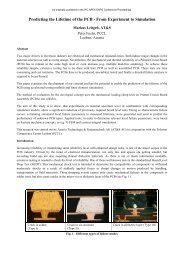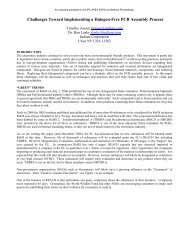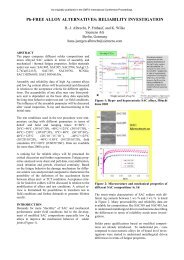Double Reflow-Induced Brittle Interfacial Failures in ... - IPC Outlook
Double Reflow-Induced Brittle Interfacial Failures in ... - IPC Outlook
Double Reflow-Induced Brittle Interfacial Failures in ... - IPC Outlook
- No tags were found...
Create successful ePaper yourself
Turn your PDF publications into a flip-book with our unique Google optimized e-Paper software.
To draw a dist<strong>in</strong>ction between the de-wet and brittle fracture modes, the solder jo<strong>in</strong>t separation surfaces (<strong>in</strong>terfaces) must beanalyzed carefully. In addition to the total separation shown <strong>in</strong> the T20 solder jo<strong>in</strong>t, the three adjacent balls P20, R20 andU20 shown <strong>in</strong> Figure 9 exhibit similar but partial separation of the solder ball from the Ni-Sn IMC. At first glance, theseparations marked by the dashed yellow l<strong>in</strong>es <strong>in</strong> Figure 9 look like the solder jo<strong>in</strong>t de-wett<strong>in</strong>g failures. However theseparated areas marked by the dashed red l<strong>in</strong>es <strong>in</strong> Figure 9, show clear <strong>in</strong>dications of crack<strong>in</strong>g or fractur<strong>in</strong>g rather than dewett<strong>in</strong>g.Figure 9 - Magnified cross section, 1000X, of PCBA, Component A, solder balls P-20, R-20, and U-20.It is assumed that once Component A was attached to the PCBA dur<strong>in</strong>g the first reflow process there was a good physical andmetallurgical connection of solder balls to the PCB and package bond pads. Dur<strong>in</strong>g the subsequent second side reflowoperation, the solder jo<strong>in</strong>ts previously formed on Component A are subjected to an <strong>in</strong>creas<strong>in</strong>g thermal stress signature. It isreasonable to expect the mechanical strength of those solder jo<strong>in</strong>t <strong>in</strong>terconnections to decrease as the temperature <strong>in</strong>creases.Concurrently, stress and stra<strong>in</strong> are <strong>in</strong>duced <strong>in</strong> the solder jo<strong>in</strong>ts due to the mismatch <strong>in</strong> coefficient of thermal expansion (CTE)between the composite structures of Component A and the PCB lam<strong>in</strong>ate. The stress <strong>in</strong> the jo<strong>in</strong>ts could be exacerbated byany warpage <strong>in</strong> either the component or the PCB. If these stresses exceed the tensile strength of the solder jo<strong>in</strong>t, fracture willoccur along the weakest <strong>in</strong>terface. At higher temperatures near-reflow, the weakest l<strong>in</strong>k typically is the IMC/solder <strong>in</strong>terfaceas <strong>in</strong>dicated <strong>in</strong> Figure 8. Based on those cross sections, it is reasonable to conclude that fracture results from the <strong>in</strong>creas<strong>in</strong>gstress on the component solder jo<strong>in</strong>ts dur<strong>in</strong>g the second reflow process due to a comb<strong>in</strong>ation of CTE mismatch and thecomponent and PCB warpage.There are two possible scenarios to consider. In the first scenario, the solder jo<strong>in</strong>t could be fractur<strong>in</strong>g dur<strong>in</strong>g the reflow rampup. This could be happen<strong>in</strong>g at any po<strong>in</strong>t before the solder beg<strong>in</strong>s to melt. Stress of course cannot be transferred to the IMC<strong>in</strong>terface once the solder has melted. Although vapor phase reflow is rapid and provides more uniform heat<strong>in</strong>g than forcedconvection IR reflow, temperature gradients will exist across components. Solder jo<strong>in</strong>ts <strong>in</strong> the outer rows of the perimeterarray are expected to reach the solder melt<strong>in</strong>g po<strong>in</strong>t a f<strong>in</strong>ite time before the <strong>in</strong>ner rows. The differential melt<strong>in</strong>g may generateadditional local stresses that could add to the any global stresses generated by differences <strong>in</strong> component and PCB CTE andwarpage. Once the balls on the perimeter of the package melt, all the stress <strong>in</strong> the package is transferred to <strong>in</strong>ner unmeltedballs, which could result <strong>in</strong> fracture at those sites.
Figure 10: A warpage displacement map across the overmolded area of Component A measured dur<strong>in</strong>g temperatureramp up at 220°C.Figure 11: A warpage displacement map for the PCB footpr<strong>in</strong>t match<strong>in</strong>g Component A. The measurements weremade dur<strong>in</strong>g temperature ramp up at 220°C.The thermal shadow Moiré data <strong>in</strong> Table 2 <strong>in</strong>dicate a net displacement or warpage of Component A relative to the PCB ofapproximately 4 mils dur<strong>in</strong>g heat<strong>in</strong>g <strong>in</strong> advance of melt<strong>in</strong>g or dur<strong>in</strong>g cool<strong>in</strong>g before solidification takes place (shaded Max. cells <strong>in</strong> Table 2). It must be acknowledged that there are uncerta<strong>in</strong>ties <strong>in</strong> <strong>in</strong>terpret<strong>in</strong>g these displacement measurements.First, these measurements may not reflect the component and PCBA behavior accurately as it would occur dur<strong>in</strong>g an actualfactory reflow cycle. More importantly, the amount of warpage needed to <strong>in</strong>duce solder jo<strong>in</strong>t fracture is unknown. A similaramount of warpage can create other serious BGA defects such as head on pillow (HoP) but HoP is a completely differentfailure mode [6, 7].In most applications 4 mils of warpage would be considered acceptable because defects like HoP and dropped ball would notoccur. On the other hand, solder assembly defects due to warpage can appear with deviations <strong>in</strong> warpage as small as a fewmils [8]. In the case of BGA double reflow, the magnitude of the warpage and <strong>in</strong>duced thermal stress may not be the primaryconsideration. The more important factor may be the strength of the solder <strong>in</strong>terconnection at higher temperatures close tothe melt<strong>in</strong>g and solidification po<strong>in</strong>ts of the solder. Consequently, it is conceivable that a small stress applied to the solderjo<strong>in</strong>t at high temperature when the jo<strong>in</strong>t has its lowest strength could cause a brittle <strong>in</strong>terfacial fracture.Corrective ActionThe obvious path for elim<strong>in</strong>ation of the failures <strong>in</strong> this design was to subject the BGA-side of the PCBA to only a s<strong>in</strong>glereflow pass. This corrective action was implemented successfully. The solder<strong>in</strong>g of the heavy daughter card modules on thenon-BGA side of the board was achieved by modify<strong>in</strong>g other aspects of the assembly process.The root cause analysis and subsequent successful corrective action <strong>in</strong>dicate that <strong>in</strong> order to prevent double reflow defects,BGA components should not be subjected to multiple reflow passes. These double reflow defects could be anothermanifestation of warpage-related assembly defects that are <strong>in</strong>creas<strong>in</strong>g across the <strong>in</strong>dustry. A risk assessment is recommendedwhenever double reflow assembly of BGA components is proposed. The assessment should <strong>in</strong>clude evaluation of dynamicwarpage data for the BGA components used <strong>in</strong> the design.
















